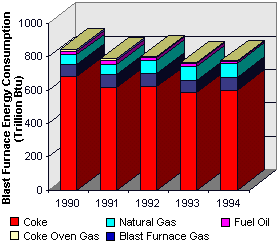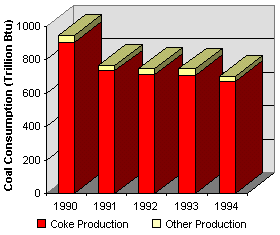Blast Furnace: Energy Consumption
|
Annual Statistical Report, American Iron and Steel Institute, 1994. |
Equipment
Combustion Technology
Energy Consumption
Process Description
R&D Trends
By far the largest source of energy for the blast furnace is coal. Total coal consumption in the iron and steel industry in 1994 was 694.41 trillion Btu, of which roughly 96% was used for coke production, while the remainder was used in such operations as electricity generation. For each year from 1990 through 1994, total coke consumption in the industry exceeded production, with the balance assumed purchased from other sources. Of the total coke consumption for each of these years, greater than 99% was by blast furnaces. Four other sources of energy play significant role in blast furnace operation, namely natural gas, blast furnace gas, fuel oil, and coke oven gas. Through the next decade at least, the energy consumption profile will continue to change significantly.
Blast Furnace Operation:

Glossary
Electricity Generation – Most of the generated electricity is used to power air compressors and other electrical systems.
Energy Consumption Profile – From 1990 through 1994, the blast furnace energy consumption profile changed as follows:
- Coke consumption down 12%
- Blast furnace gas consumption relatively flat
- Natural Gas consumption is up 52%
- Fuel oil consumption down 62%
- Coke oven gas consumption down 56%
Annual Statistical Report, American Iron and Steel Institute, 1994

